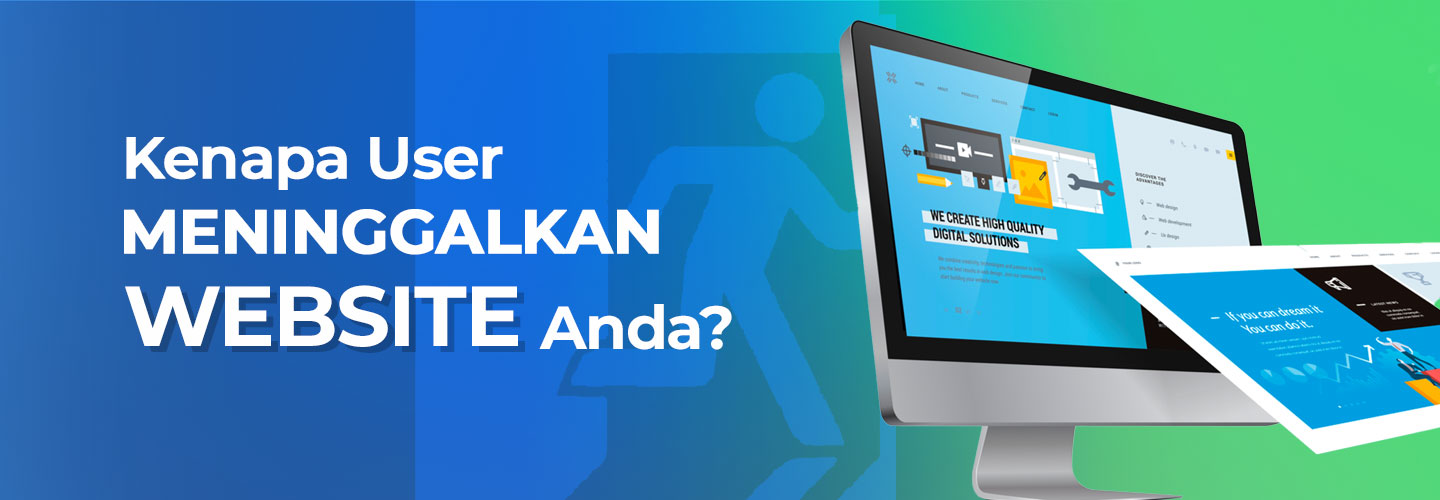Why Visitors Leaving Your Website

It is undeniable that the website is one of the important things that can determine the success of selling your product. People who are increasingly easy to access technology and the internet prefer to make online transactions.
Making a website seem trivial, even though there are many factors that need to be considered so that it functions as expected. Therefore, many companies and brands are giving more focus to websites.
Types of Website Users Based on Their Activities
Apart from planning the design and appearance of the website, it is important to pay attention to the ease of browsing a website. A good website appearance does not guarantee that visitors will continue to browse until they make a purchase.
Many things can influence a visitor's decision in their browsing experience, including the reasons they leave the website. Based on three types of website users or visitors, namely:
1. Just Browsing Wanderers
This type of visitor will almost never make transactions on your website. They're curious about your product, but they're just browsing and have no intention of buying anytime soon. Website visitors might be students doing research, business competitors looking at your website, or parents who accidentally clicked on your ad.
Just Browsing Wanderers comprises the bulk of visitors. If you ask them why they didn't buy, their answer will not give you satisfaction because they didn't have the intention to buy in the first place.
2. Determined Heroes
Conversely, determined heroes will always make it through to selling the products offered on your website. This means they will buy even if their experience as a buyer is filled with struggles and obstacles (on your website). They are the best customers, but studying their behavior won't be very helpful because they won't give much constructive criticism.
3. Undecided Explorers
Undecided Explorers is an indecisive visitor and full of judgment in making decisions. Some will move easily to another website or product if they find usability issues or incompatibilities in the product design.
Everything else will remain on the website and product selection. This half-hearted mindset makes them the perfect customer to learn from. They can explain what they are considering, express objections, and can help you convince other visitors who are still unsure about choosing products on the website.
How to Uncover Why People Leave Your Website
Visitors who come to a website do have different intentions. However, you need the right way to encourage them to take action as expected. In order to identify problems experienced by website visitors, do the following:
1. Set up a point of conversion survey
Post-purchase surveys are surveys that need to be filled out to find out feedback from visitors right after making a purchase. In addition to filling out surveys using numbers or stars to assess user satisfaction, open-ended questions can also be included.
Hearing from visitors lets you know why they canceled the transaction. You can also find out what they like about your website as well as ask for opinions on things that could be improved or completed on your website.
2. Watch the session recording from Explorer
After identifying which buyers were happy or doubtful about their experience, you can use the recording tool to be able to see the behavior of explorers visiting your website. Combining observations of their online behavior with the qualitative feedback they have provided will give you a deeper understanding of their experience, as well as ways to improve it.
3. Get feedback from the sales and support team
The sales and support team are at the forefront. They also have first-hand knowledge of your customers' fears, worries and barriers to making a purchase. So it is important to listen to opinions and input from the internal team that directly handles this matter.
A comfortable and pleasant experience is not only felt by the external side (website visitors or consumers), but also from the internal team who deal with this on a daily basis.
You can also get feedback by interviewing sales of other companies that have sold similar products in person or over the phone. Especially if they have longer experience in their field.
4. Do a user test
Karl Blanks and Ben Jesson, authors of In Making Websites Win, say user testing tends to be the most successful technique. You can ask friends or anyone to participate.
Once your website is sufficiently perfect, ask people who are willing to participate to test your website according to the intended demographic and psychographic criteria. From the results of these tests, do an analysis of the feedback that can be processed and discussed again to improve the website experience to purchase your product.
What to Do After Identification of Emerging Problems?
Once you find the problems Explorer encounters, make sure your website handles the most significant bottlenecks and make sure your product can solve their problems too. The approach you take must be adjusted to the obstacles or problems encountered.
If there are customers who don't fully understand the benefits of your product, the most appropriate solution to solve the problem is to explain the benefits of the product on your website and advertisements.
Blanks and Jesson write, “If visitors think the product is too expensive, then justify the price. If they don't trust the company, show evidence that the company can be trusted. If visitors are still considering their decision, then give reasons so they don't hesitate to continue buying."
After getting qualitative and quantitative feedback, you can discuss with the internal team what needs to be improved and improved. That way, the experience of website visitors can be maximized and increase sales of your products.
